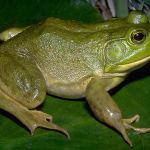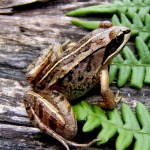This handsome fellow is Lithobates catesbianus - otherwise known as the American Bullfrog. He is native to North America and was packaged up and sent to the Swedish biologist, Carl von Linné (1707-1778) by Mark Catesby in colonial times. Linné established the order of taxonomy that remains in use today. He named the new frog Rana catesbiana in Catesby’s honor. The original binomial nomenclature name has recently been updated.
Jump forward a couple hundred years and we find that the American Bullfrog has expanded its original eastern range. Those large juicy legs have found their way onto many a dinner plate and to meet the demand frog farms were created throughout the country. Many of the frogs, being the mobile creatures that they are, escaped into the local habitat. Consequently, the American Bullfrog is now found in the wild throughout America. This is good news, bad news, but before we get into that, let’s learn a little bit more about this guy.
The American Bullfrog is an amphibian which means it lives two lives - one in water and one on land. He starts out as an egg in a thin gelatinous egg sheet with hundreds or thousands of sibling eggs. His mother heard the deep-voiced “Rumm rumm rrrrrumm” of his father near some large pond and answered the call. Father may have had to wrestle with other American Bullfrogs in order to maintain his good calling spot. Mother’s ears were tuned to father’s call and she chose the strongest that she heard. This all happened in spring or early summer.
The eggs that survive predators hatch into tadpoles in four or five days and may spend the next year transforming into a frog through metamorphosis. As a tadpole (also known as a pollywog) he will use his unique jaws to eat plant matter and detritus (the dead matter that collects at the bottom of the pond). He breathes with gills and also absorbs oxygen and water through his skin. He gets around with his tail, like a fish, so he can swim away from predators or hide on the bottom. Nevertheless, most American Bullfrog tadpoles will never make it to frog-hood.
As an adult, the American Bullfrog is the largest North American frog. Adults can range from about 3″ to 8″ in length from tailbone to snout. Frogs are ectothermic animals which means they depend on the environment to maintain their body temperature. Birds and mammals (like us) use most of their calorie intake to maintain their body heat. On the other hand, the frog’s calories can go into new growth. American Bullfrogs continue to grow throughout their lives for up to eight years.
Notice some of the physical characteristics of this fine specimen to the right. He has horizontal pupils that are capable of looking forward, backward, up and down. His eardrums (tympanums) are located directly behind the eyes. Tympanums of male frogs are larger than the eyes - females tympanums are about the same size as the eyes. His green skin is smooth and he has no folds of skin running in parallel lines down his back (dorsolateral folds) like his cousin the green frog. His legs are long for leaping and his back feet are webbed for swimming. He is a light color underneath which is typical for frogs and toads. A bird looking down on the frog in the water would see a dark green shape that blends into the color of the pond bottom. A fish looking up at the frog would see a light colored shape that blends into the color of the sky. The two lumps on the back are typical of an older American Bullfrog. The males make their call with a pair of vocal sacs that extend out on both sides of their throat.
fine specimen to the right. He has horizontal pupils that are capable of looking forward, backward, up and down. His eardrums (tympanums) are located directly behind the eyes. Tympanums of male frogs are larger than the eyes - females tympanums are about the same size as the eyes. His green skin is smooth and he has no folds of skin running in parallel lines down his back (dorsolateral folds) like his cousin the green frog. His legs are long for leaping and his back feet are webbed for swimming. He is a light color underneath which is typical for frogs and toads. A bird looking down on the frog in the water would see a dark green shape that blends into the color of the pond bottom. A fish looking up at the frog would see a light colored shape that blends into the color of the sky. The two lumps on the back are typical of an older American Bullfrog. The males make their call with a pair of vocal sacs that extend out on both sides of their throat.
The good news is that American Bullfrogs play an important role in the ecosystem by controlling insects and providing food along the food chain in its three phases. Frog legs are enjoyed by many, and are said to taste like chicken. Kids and adults can get up close and personal with them in activities like the bullfrog races held at the annual Rayne, Louisiana Frog Festival.
The bad news is that American Bullfrogs are voracious eaters and will swallow anything that they can fit into their mouths - including other frogs. Bullfrogs introduced to a new pond can decimate the local frog population quickly. In Arkansas, bullfrogs are the only frogs that can be hunted. You can catch or gig up to 18 of them a day from April to December if you have a fishing license and keep them for personal use only. No other frogs or toads can be taken from the wild without a capture permit.
Although the American Bullfrog is not on any endangered species list, it is nevertheless susceptible to contaminated water. Ponds that have been polluted with pesticide and herbicide runoff can do significant damage to frog and toad populations because of their permeable skins. For example, water concentrations of the herbicide Atrazine that are far below the EPA limit for human drinking water have been shown to create significant problems in frog hormones and breeding. (Note: Atrazine use has been banned in the European Union for a decade!)
So the American Bullfrog is the Bald Eagle of our frog community. Learn more about him and his frog and toad cousins at the website dedicated to the little creatures Arkansas Frogs and Toads. You will also learn to identify all the frogs and toads by their calls and can then contribute to our understanding of them through citizen science. Become a monitor of frogs and toads through FrogWatch USA.


